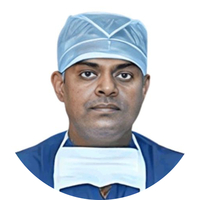Carpal tunnel surgery is a minor surgical procedure used to treat and manage carpal tunnel syndrome. Carpal tunnel syndrome is a painful condition that occurs in the wrist.
Investigations prior to the procedure involve routine blood tests, radiological tests and nerve-muscle studies. The surgery is of short duration with limited complications and has good results.
Postoperative care and management are usually uneventful and are oriented towards proper mobilisation and physiotherapy of the wrist.
- What is carpal tunnel surgery
- Indications for the surgery
- Contraindications for surgery
- Preparations before surgery
- What happens during surgery
- Risks and complications of the surgery
- Aftercare, discharge and follow up
- Takeaway
What is carpal tunnel surgery
The carpal tunnel is a small narrow canal in the wrist. It is surrounded by the bones of the wrist (carpal bones) and ligaments (the connective tissue that joins bone to bone). The tunnel contains a nerve, called as median nerve (which supplies a few muscles of the hand), and tendons (the connective tissue that attaches muscle to bone). When the median nerve gets compressed due to pressure from the surrounding tendons or any swelling, it causes painful symptoms in the wrist. This condition is known as carpal tunnel syndrome.
Surgical management condition by releasing the pressure in the canal is known as carpal tunnel surgery. The surgery is a minor procedure with a high success rate. It is performed by using either of the two methods:
- Open carpal tunnel release
- Endoscopic carpal tunnel release
(Read more: Hand Pain)
Indications for the surgery
This surgery is advised for patients with a confirmed diagnosis of carpal tunnel syndrome and when conservative (non-surgical) interventions have failed. The symptoms of carpal tunnel syndrome include:
- Tingling and pain in the fingers especially the thumb and index finger (Read more: Thumb pain)
- Reduced sensation in the fingers
- Complete loss of sensation in the fingers or numbness
- Difficulty in performing simple tasks such as
- Turning a steering wheel
- Handling small objects
- Using a keyboard
- Writing for long durations
- Later symptoms may include weakness in the hand, difficulty in performing finer actions (buttoning or unbuttoning clothes), or continuously dropping objects
The symptoms initially occur only during an activity of the wrist but as the condition progresses the symptoms become constant and more severe in intensity.
Contraindications for surgery
The surgery has no relative contraindications. However, a few points are to be noted before considering surgery:
- If the pain is managed by conservative methods and lifestyle changes, surgery can be delayed.
- Other conditions may mimic carpal tunnel syndrome. These should be ruled out.
- If the patient has any pre-existing conditions (such as diabetes, heart disease, etc.), they need to be under control prior to the surgery to reduce anaesthetic and post-operative complications.
(Read more: Repetitive stress injury)
Preparations before surgery
A general surgeon or an orthopaedic surgeon (bone doctor) performs the surgery. A detailed history of the patient is taken, which includes the symptoms of the patient, family history (genetic predisposition is a risk factor) and medication history. A physical examination of the wrist helps in assessing the severity of the disease.
Medications, if any, for any pre-existing conditions may be altered or stopped as per the surgeon's orders before surgery.
Investigations before surgery include:
- Routine blood tests
- Thyroid function tests (TFT): hypothyroidism is seen to have a causative role in developing carpal tunnel syndrome
- Chest X-ray
- X-ray of the wrist to rule out any injuries in the wrist or signs of arthritis
- ECG
- Electromyography (EMG): it is a special investigation that checks the condition of the nerves and the muscles that the nerve supplies. In carpal tunnel syndrome, the median nerve gets compressed which results in muscle weakness of the thumb and index finger
- MRI of the wrist may be done to see the extent of tunnel narrowing
The surgery is done via daycare admission (the patient is admitted in the morning and discharged by the evening). The patient is told to arrange a ride back home since after the surgery the patient will have difficulty driving. Prior to the day of the surgery, the patient is told to fast overnight.
On the day of the surgery, the patient arrives at the hospital with all the relevant investigations and documents and gets admitted. The patient changes into the hospital attire and a final review of the patient is done by the surgeon and nurses before clearing for surgery. Written consent is taken from the patient after the surgeon has explained the technique of the surgery and the associated risks and complications. The area of surgery is shaved (part preparation) and the wrist to be operated on is marked. Thereafter the patient is shifted into the minor operation theatre (OT).
What happens during surgery
The patient is asked to lie down supine (on their back) on the operating table. A monitor is attached to track vitals (heart rate, blood pressure, oxygen saturation). An IV cannula is inserted through which medications for the procedure will be administered. The wrist to be operated on is cleaned and covered with surgical drapes.
The procedure is done under regional anaesthesia known as a regional block (where the specific limb is made numb – in this case, the arm). In rare cases, general anaesthesia may be administered.
There are two approaches to doing the surgery. They are:
- Open release of the tunnel: The surgeon makes an incision about two inches long and then uses surgical tools to cut the tunnel ligaments resulting in increasing the tunnel space which releases pressure on the median nerve.
- Endoscopic release of the tunnel: in this approach, the surgeon makes two incisions, one on the palm and the other on the wrist each half-inch in length. Through one incision, a small camera is passed which helps the surgeon visualise the internal structure of the wrist and, through the other, special surgical tools are inserted to cut the ligament and thereby widen the tunnel space. The advantages of this procedure are that the incisions are small and post-operative pain is less. However, it is costlier as compared to open surgery.
After the release of the ligaments, the incisions are sutured (stitched) with non-absorbable sutures (non-dissolving). The hand and wrist will either be placed in a splint or heavily bandaged to prevent movement at the wrist joint. Care is taken to ensure that the bandage is not too tight and the patient can move the ends of the fingers slightly. The surgery is of short duration and takes about 10 to 30 minutes.
Aftercare, discharge and follow up
After the procedure, the patient is shifted from the OT and kept under observation for a few hours. Pain at the site of surgery is managed by analgesics. Return of sensation to the arm shows the wearing-off of anaesthesia. A discharge summary is prepared by the doctor, which includes relevant medications and advice on wound care. These typically include:
- Continuation of medication for pre-existing conditions, if any
- Antibiotics and analgesics to prevent infection and pain respectively
- Post-surgery swelling and pain will be there for 12 to 24 hours and thereafter reduces as the days progress
- Strenuous activities with the hand are to be avoided until the bandage comes off
- While bathing, ensure the bandage stays dry
- Movement at the fingertips is advised to the patient to reduce stiffness at the wrist joint
- Advice on certain lifestyle changes will be advised to facilitate recovery and prevent the recurrence of the symptoms
The patient experiences significant relief from the symptoms after the surgery. The doctor should be notified if the patient experiences any of the following symptoms
- Excessive pain or swelling
- Increased tingling or loss of sensation in the arm
- Excessive bleeding
- Fever
The bandage is removed after 1 to 2 weeks post-surgery, at the first follow-up. A certain amount of stiffness is expected at the wrist joint. The sutures will be cut and the wound will be examined to see the progress of healing.
The doctor will prescribe exercises to improve the mobility of the wrist. This also helps accelerate healing. In some cases, serial physiotherapy sessions (known as occupational physiotherapy) are advised to regain proper hand function. Light work with the hand can be started once the bandages are removed. Full regain of strength usually takes up to 2 months. In extreme cases, complete healing may be delayed by up to a year.
Takeaway
Carpal tunnel surgery is a minor surgical procedure advised when the symptoms of carpal tunnel syndrome severely affect daily activities, after non-surgical management is proven to be unsuccessful. The surgery is of short duration with a high success rate and minimal complications, with a low recurrence rate. The endoscopic approach of surgery is more beneficial since it has minimal scarring and post-op pain as compared to the open surgery approach. A significant component of aftercare can involve serial physiotherapy sessions to regain normal functioning of the hand and wrist.
Surgery Cost In Your City
Doctors for Carpal tunnel surgery

Dr. Manoj Kumar S
Orthopedics
8 Years of Experience

Dr. Ankur Saurav
Orthopedics
20 Years of Experience

Dr. Pritish Singh
Orthopedics
12 Years of Experience
















